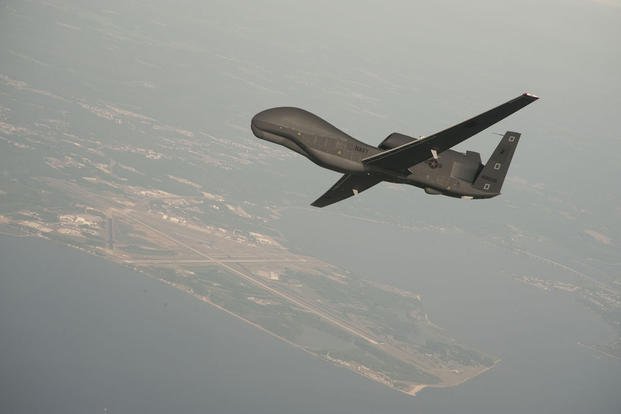While more than a dozen U.S. military aircraft flew in international airspace near Iran's borders the day the country downed an RQ-4 Global Hawk drone over the Strait of Hormuz last month, officials with U.S. Central Command say the U.S. was never "warned" before Iran took out the drone, contrary to the regime's statements.
After analysis, CENTCOM officials concluded there were "six different occasions where Iranian air defense stations queried or warned U.S. aircraft and [unmanned aerial vehicles] on the international guard radio channel" in the 12 hours prior to and following the shootdown, CENTCOM spokesman Navy Capt. Bill Urban said.
"None were recorded or reported by the RQ-4 that was shot down in international airspace in the vicinity of the Strait of Hormuz, and none were received, reported or recorded by any other aircraft at the time of the shoot down," Urban said in an email response to Military.com Tuesday. "We are not aware of any Iranian attempt to warn any U.S. forces or headquarters before they executed the shoot down of the RQ-4."
Related content:
- Surveillance Ops Continue Over Gulf Despite Drone Shootdown, Air Force General Says
- Here's the New Marine Corps Weapon that Just Destroyed an Iranian Drone
- F-22s Deploy to Qatar for the First Time Amid Iran Tensions
- Iran Says it Almost Downed a P-8 Surveillance Plane. Here's What the P-8 Does
Last month, Iranian Brig. Gen. Qader Rahimzadeh, the deputy commander of Khatam al-Anbia Air Defense Base, said the Iranian military had sent the Navy-operated Global Hawk "several warnings" before ultimately downing the drone, news site Tasnim reported.
Brig. Gen. Amir Ali Hajizadeh, commander of the Islamic Revolutionary Guards aerospace force, said separately that forces refrained from shooting down a P-8 Poseidon surveillance aircraft flying in the region, and instead shot down the RQ-4, claiming the drone violated its airspace.
U.S. Central Command officials have maintained neither the RQ-4 nor P-8 -- which were on two different flight paths -- entered Iranian airspace that day, but added that U.S. aircraft routinely operate in the region.
The Global Hawk is an unmanned system used by the Air Force and Navy that's capable of flying intelligence, surveillance and reconnaissance missions at high altitudes, upward of 60,000 feet.
Following the incident, Air Force Chief of Staff Gen. David Goldfein said U.S. intelligence, surveillance and reconnaissance flights hadn't stopped or been scaled back even amid uncertainty surrounding Iran's intentions.
"Yes, we're continuing to fly," Goldfein said during a breakfast hosted by the Mitchell Institute in Washington, D.C. June 26. "We continue to fly where we need to, when we need to be there and as we do in all scenarios."
Urban on Tuesday said Iran and the U.S. do not have a deconfliction line of communications even as operations continue.
"There is no deconfliction hotline nor any direct communications between the U.S. military and Iran, except for safety of operation radio calls on guard at the tactical level," he said.
Earlier this month, President Donald Trump said the amphibious assault ship Boxer had taken out a drone, presumed to belong to Iran, that had been operating too close to the ship in the Persian Gulf. Trump said the drone flew within 1,000 yards of the Navy warship.
The Boxer was "conducting a planned inbound transit of the Strait of Hormuz" when a "fixed-wing unmanned aerial system (UAS) approached Boxer and closed within a threatening range," Pentagon spokesman Jonathan Hoffman said in a statement July 18. "The ship took defensive action against the UAS to ensure the safety of the ship and its crew."
Marines on board the ship used their new Light Marine Air Defense Integrated System, or LMADIS, to jam the Iranian drone, officials told Military.com at the time of the incident.
The California-based 11th Marine Expeditionary Unit deployed to the Middle East with LMADIS, an anti-drone system that attaches to all-terrain vehicles and can scan the skies for enemy aircraft from aboard Navy ships.
Gen. Kenneth McKenzie, head of U.S. Central Command, separately told CBS News that there may have been a second hostile drone downed by the innovative weapons system.
-- Oriana Pawlyk can be reached at oriana.pawlyk@military.com. Follow her on Twitter at @oriana0214.











